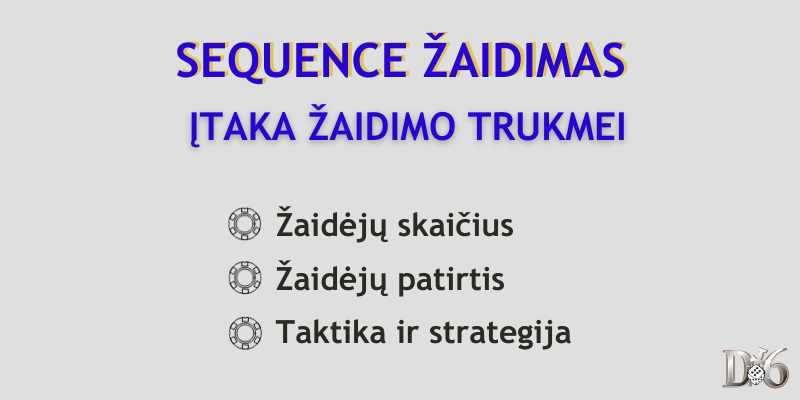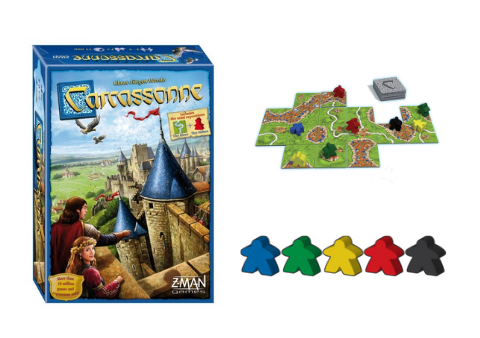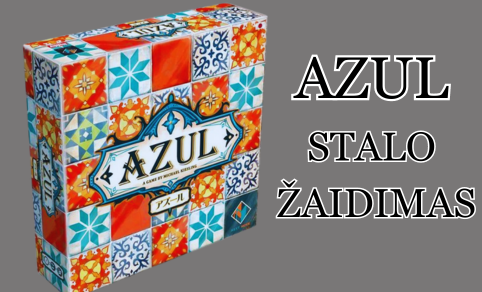Sequence is a sequencing game that combines chips on the game board with simple cards. This game has managed to win the hearts of players with its simplicity.
In this article, we will discuss the rules, strategy and pros and cons of the game. Sequence is a great choice for both beginners and experienced players looking for an intelligent combination of challenge and excitement.
Key facts
Designed for: In 1982
Type: Team, Strategic
Number of players: 2-12
Duration: 20 - 45 minutes
Complexity: Easy
Age of players: From 7 years
Sequence game - a brief introduction
✔️ The aim of the game
The cards on the game board must be used to form a row of 5 chips before your opponents can do so.
✔️ Game type
It is a team-based, strategic board game that combines strategic and card game elements. This board game has some elements of a classic card game.
In this game, players need to plan their moves and find the best way to arrange the cards in a particular order. This is not a fast-paced card game, as consistent planning and the ability to predict the opponents' moves are essential for a smooth game.
✔️ Number of players
The game can be played by 2 to 12 players, but is best suited for a group of 3 to 6 players. Players can then enjoy team play, which adds an element of social interaction and allows people to enjoy the game together.
✔️ Complexity
One of the game's best features is its adjustable difficulty level. This means that the rules are simple enough for new players to learn them quickly.
Sequence becomes more complex as players become more experienced and are able to implement more strategic options. This feature of the game makes the whole game appealing not only to newcomers but also to experienced players.
✔️ Age of players
It's a great game for all ages, but according to the rules, the recommended age is 7 years and up. In fact, it is one of those rare family games that can break the generational barrier and bring fun to both children and adults.
Children can easily learn the rules of the game and learn basic strategies. This is a great opportunity for the family to spend time together, learning strategies from their elders and interacting with each other at the same time.
Duration of the game
The length of a game can vary depending on a number of factors, including the number of players, their experience and the tactics used. The average game typically lasts between 20 and 45 minutes. Here are some of the factors that can affect the length of a game:

- Number of players: The game is more interesting and dynamic with more players. With a larger group, it may take longer to implement the desired strategies and achieve victory.
- Player experience: New players may need more time to get used to the rules of the game and to come up with and implement their own ideas. Experienced players tend to play much faster and more efficiently.
- Tactics and strategy: This is a game where it is important to think and plan your moves well. The tactics chosen by the players may vary, which can affect the length of the game itself.
What is in the game kit?
Game components:
Game board: The main part of the game is the board, which is specially designed for Sequence. The board is rectangular in shape and is divided into a grid of 10×10 squares. Each square has a symbol representing the position of a playing card.
Playing Cards: The game uses two standard decks of 52 playing cards each. The jack cards are special purpose cards used to determine where on the game board players can place or remove chips.
Game chips: The game uses game chips to help players create sequences - chips of different colours that represent a player or his team. Tokens: 50 green, 50 blue and 35 red.

Sequence game - the pros
✅ Easy rules: The rules are easy to understand, even for newcomers. This approach makes the game accessible to players of all ages and with a wide range of gaming experience.
✅ Socially attractive: The game encourages people to come together, socialise and have a great time. It helps to strengthen relationships and create pleasant memories.
✅ Strategic: This game is not a game of random chance. It is about thinking strategically and planning your moves to use your sequence cards.
✅ Promotes learning: The game is great for logical thinking, planning and concentration, and counting skills. It can be a great way to develop children's intellectual abilities, or to learn basic maths and calculate the moves made by opponents.

Sequence game - cons
❌ Game duration: Sometimes the game can take longer than expected, especially if there are more players involved in the game, who are developing their own strategies, blocking moves and playing actively. This can become inconvenient if players have limited time to play.
❌ Monotonous: If the players are inexperienced, or if the game is played with the same rules, the game can become monotonous.
❌ Lack of challenge: Although strategic in nature, the game may seem too simple for players expecting a bigger challenge. It may not appeal to participants who like more complex games.

Game rules and progress
First of all, you need to decide how the game will be played. This will depend on the number of players.
✔️ If there are 2 players, then you need to play with blue and green chips, and if there are 3 players, you need to play with blue, green and red chips.
✔️ If 4 or more players are playing, divide them into teams so that each team has the same number of players.
✔️ For two teams, use blue and green chips, and for three teams, use red chips.
✔️ There can be up to three different teams. Players must be seated in such a way that the teams alternate their positions.
✔️ The game board should be placed in the middle of the table, with enough space around the edges of the table for each player to have their own stack of chips and cards.
✔️ Joker cards must be removed from the standard deck of cards that comes with the game. They are not used.
✔️ Each player must randomly move the deck of cards to draw their card. The player who draws the lowest card becomes the dealer. The ace card is considered the highest card.
✔️ The dealer must shuffle the cards and deal the cards to each player according to the number of players.
Number of cards
The number of cards each player receives depends on the number of players:
- In a 2-player or 2-team game, each player or team receives 7 cards.
- For 3-4 players or 3-4 teams, each player must receive 6 cards.
- 5 cards for 5-7 players.
- 8-9 players are dealt 4 cards each.
- For 10-12 players - 3 cards each.

✔️ The player to the left of the dealer starts the game. The game is played clockwise.
✔️ Each card corresponds to one box on the game board. The player whose turn it is to make a move must show a card and place a chip in the space indicated by the card's symbol and discard the card into the common deck of discard cards.
✔️ If a player forgets to pick up a card before the other player starts his turn, he cannot pick up another card and will have to finish the game with fewer cards in his hand.
✔️ If the draw pile runs out of cards, the player must collect all the discarded cards and shuffle them to make a new draw pile.
Game Sequence – sequencing
The sequence should be attempted horizontally, vertically or diagonally. There are two different places on the game board for each card to place its token.
Each corner of the game board has a drawn chip. Each player will treat these spaces as if one of his colour chips were placed on them.
End of game
At the end of the game, the winner is the player who creates a sequence of five chips. This is a very tense moment, as players can be one step away from victory and unexpectedly become losers.
When a player or team has placed a sequence of five chips, they must shout "Seka!" to declare victory in this round.
The first player or team to create enough sequences wins the game. The number of sequences needed to win the game depends on the number of players or teams.
- 2 players or 2 teams - to win the game, you need to create two sequences (winning phases).
- More than 3 players or teams - must create one sequence at a time.
Alternatively, the game can be played over a set number of rounds or until a team reaches a predetermined number of points.
Special cards
There are special cards in the game, called Valetais in Lithuanian, which play a special role in the game. There are two types of Valetai: "two-eyed" and "one-eyed". Let's try to explain these special cards in more detail below.
"One Eye" Valets
One-eye Jacks are hearts and wine type cards. When a player holds a Valet of this type, he can remove one of his opponent's chips from the game board. This is a strategic move to disrupt the opponent's or opponents' moves and make victory more difficult.
A chip can be removed from any location, with one exception. A chip cannot be removed if it is part of a completed sequence. Any player may place his chips in this new location.
Once the chip is removed from the board, the player's turn is over. A player may not place one of his chips in the space he has just vacated.

"Two Eyes" Valets
When a player has a two-eyed Valet card, it can be played as a normal card. A "Two-Eye" card allows you to place one of your chips anywhere on the game board.

"Dead" cards
In Sequence, the term "dead" cards is usually used to refer to cards that have already been played and are removed from the game.
A player may discard one "dead" card from his hand during his turn. The other players must be told that this is the "dead" card. Once a card is discarded, a new card can be picked up. This can only be done once per game phase.
Understanding the concept of this card is crucial to the strategy. It helps players keep track of which spaces can no longer be used, and can help them plan sequences and prevent opponents from forming sequences.
To make effective moves and win the game, players need to know which cards have been played, which spaces are "dead" and which cards are still available.
Sequence game - scoring
In a board game, points are scored for each round or game, and players or teams can earn points for various achievements.
Sequencing: Players or teams score points for sequences created on the game board. Each sequence is worth a certain number of points, and the number of points may vary depending on the rules of the game. The normal point value is 50 points for the first sequence, 40 points for the second sequence and 30 points for the third sequence.
Removing an opponent's chip: When a player successfully uses a Valet card to remove an opponent's chip from the board, his team receives 20 points. This is an additional way to score points in the game.
Winning
The game can be played over a predetermined number of rounds or until a team has accumulated a predetermined number of points, usually 500. The first team to reach the winning number of points shall be declared the winner of the game.
Example:
Team completes the first sequence of five chips in a row on the game board. According to the rules, she receives 50 points. She then completes a second sequence and earns 40 more points. She scores a total of 90 points. The team also uses the two-eye Valet to remove the opponent's token. This action earns 20 points. These points are added to the team's point total. The game is won when either team reaches a predetermined point total.
It is important to note that house rules may vary, and some players or teams may have different point values for the sequences they create, or have additional scoring rules. It is therefore a good idea to find out the scoring rules and point values before playing this board game.
Summary
Sequence is a great team and family game suitable for all ages. Everyone can join in and play and have fun. Younger children can easily understand the rules and, depending on the luck component, can compete with more experienced players.
This board game encourages thinking, strategy and communication. It is not only a great way to spend your free time, but also to learn the subtleties of counting.
People looking for something more complex or expecting more strategy may find this board game rather limited and a bit boring.
What is the purpose of Sequence❓
From the cards you have, be the first to place a row of 5 chips on the game board before your opponents do so.
Is the Sequence board game family friendly❓
✅ Yes! Recommended for children over 7 years of age, it's a great team game.
How many people can play a board game❓
According to the rules, the game is open to 2-12 people
What is the duration of the game❓
A game usually lasts between 20 and 45 minutes. The length of the game may vary depending on the number of players, their experience and the tactics chosen.
How sequences are made❓
Sequences on the game board can be drawn horizontally, vertically or diagonally.





